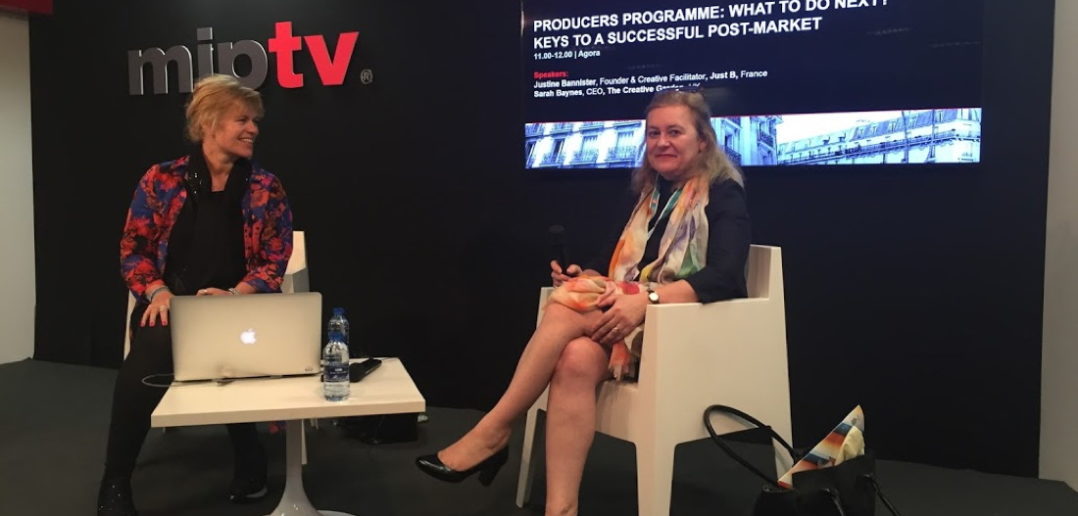The show is winding down … but what happens next? To answer this question, Justine Bannister, Founder and Creative Facilitator at Just B, and CEO Sarah Baynes of The Creative Garden provided tips for how you can make the most of MIP once home.
Their advice took the form of what Bannister called a MIPTV Autopsy:
1. Analyse your property. Does it compete in the international marketplace? Is it appropriate to the targeted broadcasters/platforms?
When pitching, “it’s always a good idea to go with a creative team and have creative materials,” even if it’s just a mood board, said Bannister. “It’s good to inspire people. They have a lot of meetings, people’s brains get full, it’s good to stand out from the crowd.”
“If you look professional, and you look as if you can deliver, all broadcasters are keen to get new blood—new people, new experiences in the mix,” said Haynes, who told attendees to ensure they “look pro” in their graphics, delivery and behaviour.
Also, don’t just focus on your own properties and presentations. Investigate what else is out there to see what’s working and what isn’t. “There are pitch guides everywhere,” said Bannister. “I would advise you to attend as many sessions as you can”—like What Buyers Want—”and find out what’s out there, who you’re approaching and who your competition is.”
People can be pretty generous, with platforms and broadcasters readily telling you if it isn’t right for them, she added. In such cases, ask for help: “Can you tell me who you think this would be appropriate for?”
In the end, Bannister said, “It’s all about reassuring them. It’s unusual these days for a broadcaster or one person to make a snap decision. It has to be decided by committee, they need to know you have a track record. If you don’t have experience, surround yourself with genius.”
2. Analyse your pitch. How was your technique? Could you read the reactions of pitchees?
Bannister, who’s done nearly 50 MIPs, confesses to having “a bit of an obsession with pitching. It’s the hardest thing to do in the world. Inside out, back to front, you have to nail the DNA.”
Also, read the room! “If you get a negative response, don’t keep labouring the point. Be sensitive to what’s going on in front of you,” she said, advising that you don’t stress it too much, either: “They’ll feel that panic. Get to know them! They’re people too.”
To this, Baynes drew upon her own experiences as a buyer: A no on the first go is not a door shut forever. “I would track people over many years” to see how they evolved, she said, and would often buy something later down the line.
3. Analyse your pitch materials. Do you have strong materials that sell your property, even just a mood board?
Help buyers see your vision, and don’t be afraid to adjust. “People don’t want to lose their baby. They want to protect it,” said Bannister. “It’s got to have 3 pigs in it, and they have to be girl pigs … but sometimes it’s okay to have 2 boy pigs and a girl pig.”
4. Analyse your meetings. Were they constructive?
“Keep being tenacious,” said Baynes. “Like a rhinoceros, brush it off, take the feedback, listen to it and check it against others’ feedback. Feedback isn’t necessarily right. Test it out but take it on board.”
Ask people what is working, what they are looking for and what the latest trend is. If you’ve got multiple projects, “you can adjust as they talk and not show them all your material,” said Bannister, who advises against “launching into a pitch like a robot. It’s got to feel like a conversation.”
“More people are taking pitches over Skype—some of the big players,” Baynes added. “I would practise being approachable, not looking worried, being able to pitch in 5 minutes, and looking in the right place”—checking, for example, where your camera and eyeline are, and double-checking what you plan to show them.
“Quite a few people get caught up on that,” said Baynes, because you can’t necessarily see what they see on the other side of the screen.
The pair also proffered 3 ways to optimise your chances of scoring a deal post-MIP:
1. Revise your agenda. Specifically, follow up on all meetings within 10 days of the market, while the momentum is there, information is fresh and people still remember you.
2. Revise your pitch. Were your company and pitches effective and relevant to the current state of the market?
3. Revise your objectives. Were your connections the right ones? Do homework and research, and contact them.
To this point, one audience member asked how to get meetings at places like Netflix or Warner Bros., which are tightly protected and don’t answer emails.
“Find out who the key people are,” said Bannister. “The days have gone where you’d go through an agent or lawyer, but they’re more accessible these days. If you’ve got their first name and surname, you’ve pretty much got their email,” given that most big companies share a similar email structure.
She also suggested using resources like the MIP Buyers Guide, where the most relevant person for you may be listed there.
“It’s tenacity,” added Baynes. “Having been on the other side, I’ve been deluged, and they’e being deluged a million times more. It’s about how you filter. If you’ve got somebody who’s got a relationship” with the person you’re trying to reach, that’s the best way to rise to the top of their pile.
Bannister also suggested, “Talk to your competition. I talk to a lot of distributors when I do distribution, and we exchange information. Someone out of the blue will have seen something.”
Yet another audience member asked how to go about starting a bidding war.
“Create something really fabulous,” Bannister said flatly. “Make sure you’ve gone to everybody. Who do you want?” (The person—who was US and China-based—floated Gaumont and Canal+ in France.) “Just tell each of them that the other wants the show really badly.”
On the other hand, that has to be true. “They’ll talk to each other!” she warned. “It takes a long time to build a reputation, but it doesn’t take long to wreck it. But as long as your project is fabulous, you’ve got a pretty good chance. That’s the thing these days, it’s got to be really exceptional. No pressure.”
Baynes said things have become a lot more complicated than our traditional binary understanding of a bidding war. Today “you have different territories, different people, different ways of getting funding”—a complex matrix of the many elements that contribute to a project, and a bidding war is more about how you leverage combinations of them. “In the past, it was 2 people bidding against each other. Now there’s complexity.”
To that point, Bannister conceded it’s worth taking those factors into account when trying to orchestrate your “bidding war.” Factor in ideal coproduction partners, based on the ideal circumstances for your show.
If you want French coproducers, remember you’d probably be obliged to do most of your shooting in France, she pointed out, and that might not be the best option; Germany or the UK might be more flexible. Look at the full constellation of what you want for your product … including where you can get the best tax breaks. Plan accordingly.
Baynes and Bannister also shared an image of what the current “viewniverse” looks like, a small example of which you can see here (and a larger version here):

“It’s very clear about who the new players are. The world has completely changed,” said Bannister.
And it will change again—”very fast, very quickly,” Baynes agreed.
“TV will become the furniture in the corner, and we’ll be watching on something else,” Bannister said. “But content will still be king. Thank goodness. That’s why we’re all here.”




